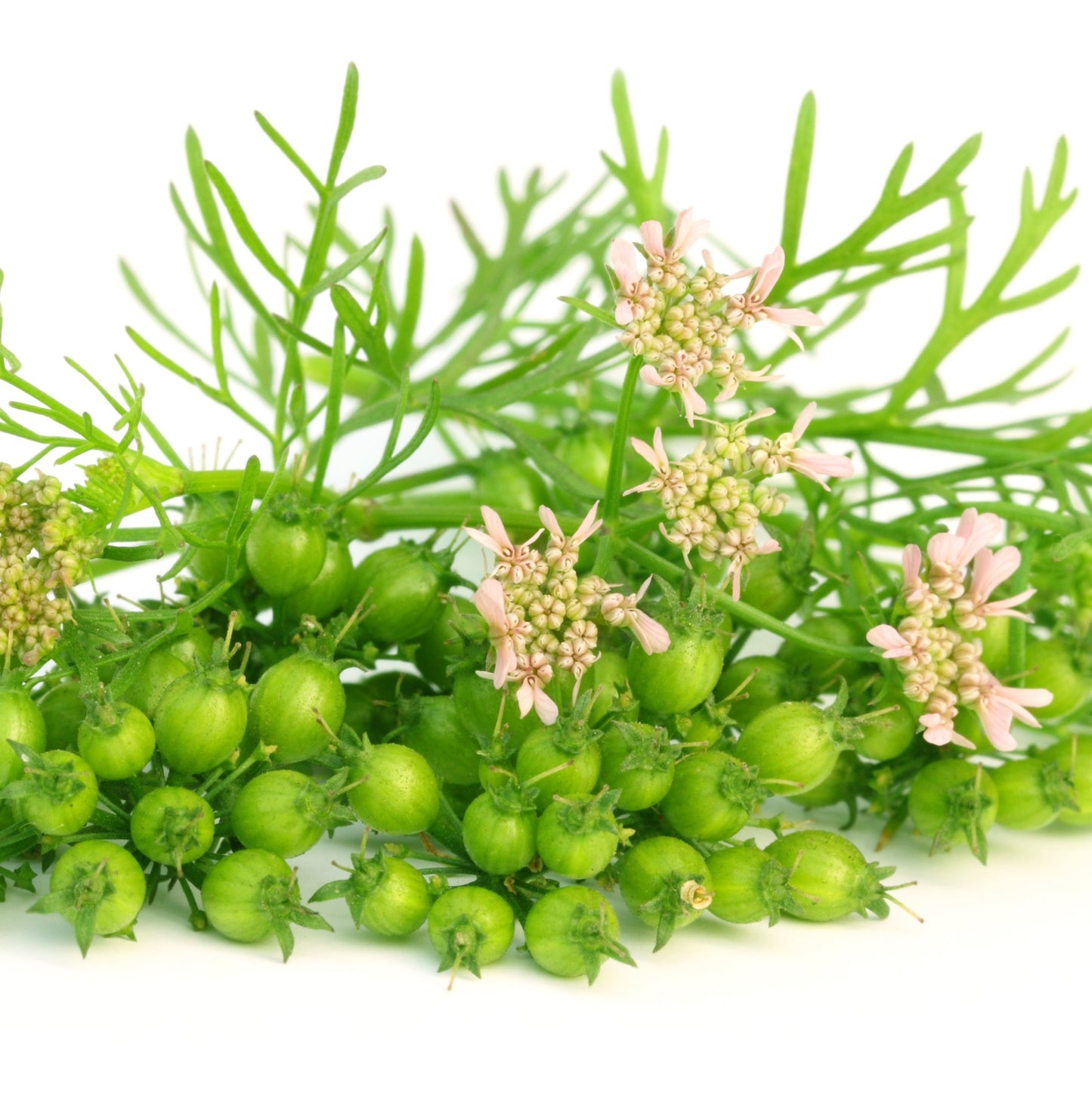TIMELESS Essential Oils
Coriander
Couldn't load pickup availability
Pure Coriander essential oil
Product Description
Botanical name
Coriandrum sativum
Extraction method / Source
Steam Distillation / crushed seeds
Aroma
Sweet, woody, spicy
Note
Middle
Odor Intensity
3
Key constituents
Linalool 58% , terpinene, alpha-pinene
Plant description
Botanical family: Apiaceae
Coriander is a fragrant annual herb which is native to Europe and Western Asia. It grows to a height of 20 inches and produces soft green leaves and small pale pink flowers in clusters known as umbels. The flowers develop into edible seeds which are dried and used as a spice or made into essential oil. The leaves are also edible, and are referred to as cilantro, but they differ from the cilantro which is commonly used in Mexican cooking.
Regions of Production
Hungary
Growing Practices
Cultivated without the use of chemical fertilizers or pesticides.
Properties
Analgesic, apertif, antispasmodic, bacteriacidal, carminative, depurative, digestive, euphoric, stimulant, stomachic, tonic
Please refer to the Glossary for terms which may be new to you.
Uses / Benefits
Helps in the treatment of rheumatism, arthritis, gout, muscle aches and pains. It helps alleviate flatulence, nausea and stomach ache. It stimulates the appetite, and has been recommended for the tretment of anorexia nervosa. Coriander is a favorite fragrance for natural soaps, cosmetics and perfume making. (Battaglia, 2003)
Fragrant influences
Helps with digestive complaints. Use together with Ginger essential oil in inhaler for nausea. May produce mild euphoria.
Modes of Administration
Topical: massage, compress, skin care
Inhalation: direct inhalation, diffuser, oil vaporizer, aromatherapy inhaler
Blends well with
Balsam Fir, Benzoin, Bergamot, Cardamom, Cinnamon, Clary Sage, Ginger, Grapefruit, Lemon, Lime, Nutmeg, Orange
Safety
Non-toxic, non-irritating, non-sensitizing
Notice
This information is for educational purposes only. It has not been evaluated by the US Food and Drug Administration. It is not intended to diagnose, treat, cure or prevent any condition or disease, and should not take the place of evaluation by a qualified health professional. Although we strive to provide information which is accurate and up to date, we cannot guarantee the accuracy or completeness of this information.
Precautions
Pure essential oils are highly concentrated plant extracts. Do not use them undiluted, or in the eyes or mucus membranes. If applying an essential oil to the skin, always dilute it with a proper carrier oil and test on a small patch of skin before applying to a large area. Do not take them internally except under the direction of a qualified professional trained in Aromatherapy. Always familiarize yourself with the safety, contraindications and proper preparation of each essential oil before use. Note that when using essential oils for children and the elderly, very low concentrations should be used. Keep all essential oils away from children and pets.
References
Althea Press, Essential Oils: Natural Remedies, 2015. Althea Press, Berkeley, CA.
Battaglia, Salvatore, The Complete Guide to Aromatherapy, Second Edition, 2003. The International Centre of Holistic Aromatherapy, Brisbane, Australia
Cooksley, Valerie Gennari, Aromatherapy: Soothing Remedies to Restore, Rejuvenate, and Heal, 2002. Prentice Hall Press, New York, NY.
Cooksley, Valerie Gennari, Aromatherapy: A Holistic Guide to Natural Healing with Essential Oils, 2015. Floramed Publishing, The Woodlands, TX.
Green, Mindy, Natural Perfumes, 1999. Interweave Press, Loveland, CO.
International Fragrance Research Association, http://www.ifraorg.org/en-us/standards (January 5, 2016).
Schnaubelt, Kurt, Advanced Aromatherapy: The Science of Essential Oil Therapy, (English translation)1998. Healing Arts Press, Rochester, VT.
Schnaubelt, Kurt, The Healing Intelligence of Essential Oils: The Science of Aromatherapy, 2011. Healing Arts Press, Rochester, VT.
Tisserand, Robert and Young, Rodney, Essential Oil Safety, 2nd edition, 2014. Churchill Livingstone Elsevier, New York, NY.
United States Food and Drug Administration, HHS, 182.1 Substances That Are Generally Recognized as Safe, 182.20 Essential oils, Oleoresins (solvent-free), and natural extractives (including distillates), http://www.gpo.gov/fdsys/CFR-2012-title21-vol3-sec182 (January 28, 2016).
TIMELESS Essential Oils guarantees the purity and quality of all our therapeutic oils. The current Certificate of Analysis is available upon request. All essential oils are best stored in an airtight container away from heat and light.


